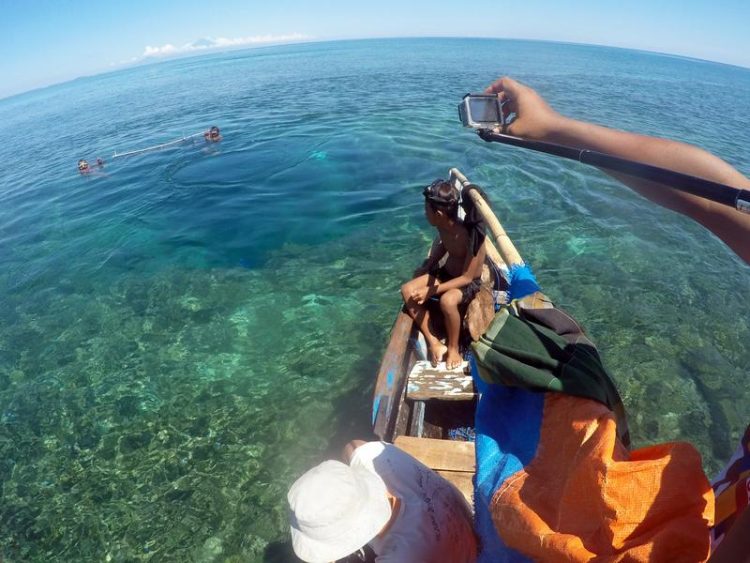Submarine springs can cause problems for coral reefs

Groundwater leak from a crater in a reef off Lombok Photo: Till Oehler, Leibniz Centre for Tropical Marine Research
Many divers are familiar with the phenomenon: when diving through a coral reef, the water can suddenly become blurred and much colder, which is often the result of groundwater seeping through the seabed after having made its way from the land over many kilometres through rock and sand layers.
Submarine groundwater springs are widespread all over the world, but have hardly been studied by scientists to date. According to previous estimates, such springs account for up to 10% of the water discharged from land into the sea.
They are particularly common in volcanic regions, where the groundwater can flow easily along fissures and cracks through the underground.
Together with partners from the Indonesian Research Centre of Geotechnolgy, Till Oehler, geologist at ZMT, discovered a large number of submarine springs in a coral reef off Lombok, a volcanic island in Indonesia.
On closer inspection they found deep cracks and crevices in the reef alongside the springs; in some cases large craters with a diameter of up to 16 metres had formed. Coral debris accumulated on the seabed, and algae had started to overgrow the reef.
Measurements by the researchers showed that a large amount of water is discharged from the individual springs in the reef: up to five litres per second. “This type of groundwater is usually heavily polluted and very rich in nutrients such as nitrate or phosphate, as it carries fertiliser and wastewater from industry, agriculture and settlements. Lombok and many other islands in the region have virtually no sewage treatment plants,” reports Dr. Till Oehler.
To investigate water chemistry, the geologists took groundwater samples from the reef and from wells on land. They found that the nitrate levels at the reef springs were 40 times higher than in the surrounding water. They were also able to trace the origin of the reef springs, which was located on Lombok in a densely populated valley region.
Coral reefs thrive best in nutrient-poor, clear water. An excess of nutrients can lead to strong algae growth. Algae then compete with corals for the settlement in the reef, resulting in overgrowth and eventual death of the corals. “In addition, the submarine groundwater springs produce water which is more acidic than seawater and can impair skeleton formation and thus coral growth.”, explains Professor Nils Moosdorf, who leads the working group “Submarine Groundwater Discharge” at ZMT.
Freshwater springs, as described by the researchers, were also found in reefs off Hawaii, Mexico and the Philippines. The ZMT scientists assume that they are widespread. Along the Pacific, for example, where continental plates collide at the Pacific Ring of Fire, islands of volcanic origin line up in front of Australia and Southeast Asia, like pearls on a chain. The area is rich in coral reefs and one of the most biodiverse marine regions on Earth and the researchers also suspect further groundwater springs there.
“Groundwater is fed by rain which is especially high during the monsoon season,” says Professor Moosdorf. “According to forecasts on the consequences of climate change, rainfall in the region is expected to become even more intense. This could lead to a further increase in submarine groundwater discharge and its nutrient load.”
Dr. Till Oehler
Leibniz Centre for Tropical Marine Research (ZMT)
Tel: 0421 – 23800 135
E-mail: till.oehler@leibniz-zmt.de
Prof. Dr. Nils Moosdorf
Leibniz Centre for Tropical Marine Research (ZMT)
Tel: Tel: 0421 – 23800 33
E-mail: nils.moosdorf@leibniz-zmt.de
Oehler, T., Bakti, H., Lubis, R. F., Purwoarminta, A., Delinom, R., & Moosdorf, N. (2019). Nutrient dynamics in submarine groundwater discharge through a coral reef (western Lombok, Indonesia). Limnology and Oceanography, lno.11240. https://doi.org/10.1002/lno.11240
Media Contact
All latest news from the category: Earth Sciences
Earth Sciences (also referred to as Geosciences), which deals with basic issues surrounding our planet, plays a vital role in the area of energy and raw materials supply.
Earth Sciences comprises subjects such as geology, geography, geological informatics, paleontology, mineralogy, petrography, crystallography, geophysics, geodesy, glaciology, cartography, photogrammetry, meteorology and seismology, early-warning systems, earthquake research and polar research.
Newest articles

Properties of new materials for microchips
… can now be measured well. Reseachers of Delft University of Technology demonstrated measuring performance properties of ultrathin silicon membranes. Making ever smaller and more powerful chips requires new ultrathin…

Floating solar’s potential
… to support sustainable development by addressing climate, water, and energy goals holistically. A new study published this week in Nature Energy raises the potential for floating solar photovoltaics (FPV)…

Skyrmions move at record speeds
… a step towards the computing of the future. An international research team led by scientists from the CNRS1 has discovered that the magnetic nanobubbles2 known as skyrmions can be…




















